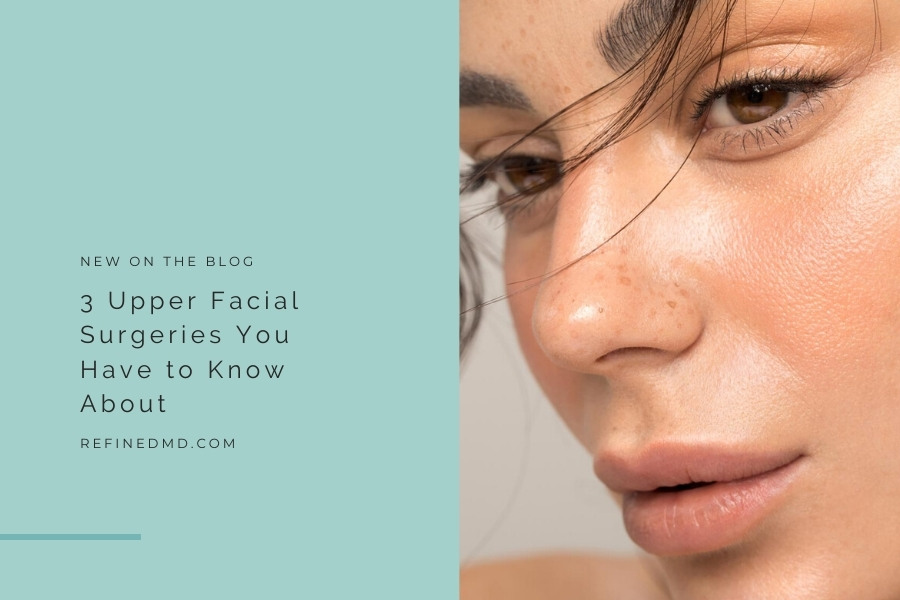
25 Aug 3 Upper Facial Surgeries You Have to Know About
Quick, name a plastic surgery for the face—if you’re like most people, a facelift first comes to mind. It’s one of the most popular procedures performed by double board-certified Dr. Sudeep Roy at RefinedMD, but a facelift only addresses the lower half of the face and the neck. The name can be misleading, especially since the first place to show aging is actually the upper half of the face (around the eyes in particular). Most patients are best suited for a combination of surgeries, often paired with non-surgical treatments, in order to get the best results. If you’re starting to notice early signs of aging, such as sagging eyelids, bags under the eyes, and droopy eyelids, you’re not alone. And there are a number of surgeries that can treat this. Here are three upper facial surgeries you have to know and the non-surgical treatments that go with them.
1. Upper blepharoplasty.
Also known as an upper eyelid lift, this surgery exclusively addresses sagging of the upper eyelids. This condition is known as ptosis, and happens to everyone eventually (to some degree). A combination of skin laxity, gravity, and a tired levator muscle creates this condition that can make you look older and more tired than you are (and often angry). An upper blepharoplasty removes a small amount of skin on the upper eyelid with the incision hidden in the natural eyelid’s crease. Most people feel confident going out and about in the world 7 – 10 days after their surgery. You can expect stitches that are visible for one week after the surgery.
Lines and wrinkles are part of what causes eyelid sagging (or a side effect of it). Many people opt for Botox injections around the eyes to reduce wrinkles and “train” the muscles causing the wrinkles to be weaker. Starting a Botox regimen after healing from an upper bleph is a great investment. You can also turn back the clock by addressing skin quality around the eyes. Laser skin rejuvenation and chemical peels can remove the sun spots and age spots that often happen in this area. Finally, upgrading to a medical-grade sunscreen and making sure to apply it liberally around the eyes can safeguard your blepharoplasty and minimize future laxity and UV damage.
2. Lower blepharoplasty.
Commonly paired with an upper bleph, a lower blepharoplasty (or lower eyelid lift) only addresses issues below the eyes. This can mean bags, sagging, fat pockets, laxity, or a combination of all of these. This area is particularly prone to aging and might be the first facial cosmetic surgery you consider. If only fat pockets need to be removed, incisions are hidden inside the eyelid. If you also need skin removed, an incision is hidden along the lower lashline. Since the eye region is highly vascular, both types of blephs heal relatively quickly. The lower blepharoplasty takes a little longer, with most patients confidently returning to full social interactions around ten days after their surgery. Swelling and bruising is common for the first week, and usually it is only bruising (which can be hidden with makeup) for the second week.
It is very common to pair a lower blepharoplasty with dermal fillers. However, only an expert—like a surgeon—should handle fillers in this very delicate region. Too much, too little, or a subpar injection can make dermal fillers in this area look very strange. Otherwise, all of the non-surgical treatments that are typically paired with an upper bleph can also be applied to a lower blepharoplasty.
3. Brow lift.
Only a brow lift addresses sagging and dropping along the browline. It is often paired with an upper bleph and can be suitable for both men and women. Sometimes it is not the skin of the upper eyelid that is causing drooping, but rather the forehead. Browlift incisions are small and hidden within the hairline. Recovery is similar to a blepharoplasty, but you may feel comfortable returning to social activities even sooner because there will not be such obvious swelling and bruising (as it is typically retained along the hairline).
Botox in the forehead after healing can be a great complement to a browlift. Botox can help keep wrinkles in check for longer. Laser skin rejuvenation, peels, and other non-surgical treatments to improve the skin quality of the brow also go great with a lift.
Are you ready to look years younger, happier, and healthier? Contact Dr. Sudeep Roy at RefinedMD to learn more about upper facial surgery options. Give us a call during business hours, or for the fastest response simply complete the online contact form at any time.
